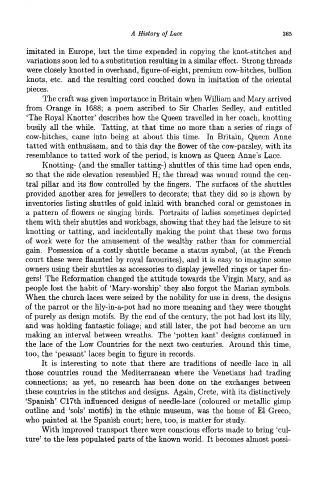Page 372 - J. C. Turner - History and Science of Knots
P. 372
A History of Lace 365
imitated in Europe, but the time expended in copying the knot-stitches and
variations soon led to a substitution resulting in a similar effect. Strong threads
were closely knotted in overhand, figure-of-eight, premium cow-hitches, bullion
knots, etc. and the resulting cord couched down in imitation of the oriental
pieces.
The craft was given importance in Britain when William and Mary arrived
from Orange in 1688; a poem ascribed to Sir Charles Sedley, and entitled
`The Royal Knotter' describes how the Queen travelled in her coach, knotting
busily all the while. Tatting, at that time no more than a series of rings of
cow-hitches, came into being at about this time. In Britain, Queen Anne
tatted with enthusiasm, and to this day the flower of the cow-parsley, with its
resemblance to tatted work of the period, is known as Queen Anne's Lace.
Knotting- (and the smaller tatting-) shuttles of this time had open ends,
so that the side elevation resembled H; the thread was wound round the cen-
tral pillar and its flow controlled by the fingers. The surfaces of the shuttles
provided another area for jewellers to decorate; that they did so is shown by
inventories listing shuttles of gold inlaid with branched coral or gemstones in
a pattern of flowers or singing birds. Portraits of ladies sometimes depicted
them with their shuttles and workbags, showing that they had the leisure to sit
knotting or tatting, and incidentally making the point that these two forms
of work were for the amusement of the wealthy rather than for commercial
gain. Possession of a costly shuttle became a status symbol, (at the French
court these were flaunted by royal favourites), and it is easy to imagine some
owners using their shuttles as accessories to display jewelled rings or taper fin-
gers! The Reformation changed the attitude towards the Virgin Mary, and as
people lost the habit of `Mary-worship' they also forgot the Marian symbols.
When the church laces were seized by the nobility for use in dress, the designs
of the parrot or the lily-in-a-pot had no more meaning and they were thought
of purely as design motifs. By the end of the century, the pot had lost its lily,
and was holding fantastic foliage; and still later, the pot had become an urn
making an interval between wreaths. The `potten kant' designs continued in
the lace of the Low Countries for the next two centuries. Around this time,
too, the `peasant' laces begin to figure in records.
It is interesting to note that there are traditions of needle lace in all
those countries round the Mediterranean where the Venetians had trading
connections; as yet, no research has been done on the exchanges between
these countries in the stitches and designs. Again, Crete, with its distinctively
`Spanish' C17th influenced designs of needle-lace (coloured or metallic gimp
outline and `sols' motifs) in the ethnic museum, was the home of El Greco,
who painted at the Spanish court; here, too, is matter for study.
With improved transport there were conscious efforts made to bring 'cul-
ture' to the less populated parts of the known world. It becomes almost possi-

